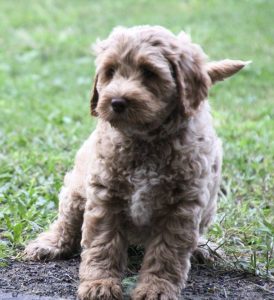PUPPY TOILET TRAINING
Cobberdogs are companion dogs, and ideally suited to being indoors with their human family much of the time.
Make life easier for you and your puppy by giving toilet training the time and commitment that it requires to be successful! If you put in the effort it should only take 2 weeks to be complete.
The great news is that dogs are naturally clean animals; dogs in the wild are really fussy about keeping their dens clean and will not usually toilet where they sleep or eat! At Ridgy Didge, we take advantage of this natural behaviour and facilitate toilet training long before the pup comes home to you.
When our pups are a few weeks old, they go outside to their large puppy pen with their mother – it has clearly delineated indoor and outdoor areas just like your home. There’s a little house for sleeping, concrete outside area for feeding, and grassy yard and garden for play.
With free run in their puppy pen, these Ridgy Didge puppies naturally start to develop good toileting habits and quickly learn to toilet out in the yard, away from their sleeping and feeding areas. In this environment, as the pup grows, these habits would naturally continue to be cemented and developed...
BUT...
Once the pup goes home with you, family routine is so different and everything is so big and unfamiliar! Running out to toilet is no longer so simple for your small puppy! Your pup will really depend on you to give them very clear guidance and routine to continue their successful toileting habits.
Puppy toilet training at your home must begin right from Day 1! Your puppy will continue to unconsciously develop habits - good or bad - around toileting and a toileting area, based on familiarity, smell (urine, poo or ammonia), surface (grass, sand, newspaper, concrete, carpet, tiles, etc.), and some functional things like sleeping, playing and eating. It’s now up to you to guide your pup so the habits and associations developed are good ones!
Right from the first day you take your puppy home, the closer you can watch your puppy, the less chance there will be for accidents to happen. Your puppy will understand quickly and be more secure and confident. Your puppy will quickly develop physical control and mental acuity around this whole process. Happy puppy, happy family!
With all that in mind, we developed a training guideline.
RIDGY DIDGE 10 POINTS TO TOILET TRAINING
- Do NOT give the puppy free run of your home until they are toilet trained.
Have a small baby/puppy pen or gated room (laundry/bathroom) close to your main family life. This area should have the puppy’s water and feeding bowls, and bed. If the pup toilets on an inside floor, there may be an association with that spot, and they will go back to that spot again and again if allowed! - Take the puppy outside to toilet.
Your Ridgy Didge puppy will already be used to toileting outside on the grass, so keep the early habit developing. Having the pup on a leash makes it easy to keep them focused on the job instead of play. If you go to the same area each time, your puppy will develop a habit of toileting in that spot and will go there independently when trained. - Always go to the outside to toilet through the same door.
This will keep things simple for your puppy. - Put newspaper at the door to the outside.
If the puppy goes there and doesn’t make it outside, newspaper will absorb the accident! - Always take your pup out to toilet after waking, feeding, and last thing at night.
Toilet your pup first thing in the morning and after daytime sleeps, and after each feed. Toilet your pup last thing at night before your go to bed, so you improve the chances of the pup going through the night without an accident. - Give a simple voice command.
Each time you take the puppy out to toilet, use a command so your pup learns to associate your command with toileting – ‘toilet’ for example. Just a word, not a sentence; the dog will recognise the tone and sound more than the language! - Don’t give water after 5pm.
Until your pup is well toilet trained and mature, this will help to keep the puppy settled at night. Because of this water restriction, give fresh meat instead of kibble in the evenings – kibble will make your pup thirsty! - Get to know your puppy’s toilet signs.
If you watch your puppy carefully, you will begin to notice the signs he shows when needs to toilet – agitation, restlessness, sniffing the ground, walking in circles… When you see this, carry the pup quickly and calmly outside and let them toilet; on a lead is really good so the pup doesn’t get distracted with play! - Do NOT punish the puppy for accidents, reward successful outside toileting
Punishment will confuse and stress your puppy and they may avoid toileting when you are around to avoid being punished, then the mistakes will escalate! Check that you are consistently following all the above guidelines and patiently continue with training.
As soon as your puppy toilets properly, give lots of praise and use your toilet command in the praise so your pup develops a strong association – “good dog, toilet”. - After a toileting accident, clean up properly.
Clean the area with a non-ammonia based product. There are lot around, and they don't need to be expensive pet products. Just Google it if you need to! Ammonia based products smell like old urine to your puppy and will encourage him to toilet there!
If the puppy soils the crate overnight or when confined, wash the bedding as above, and put it back. Any lingering smells will encourage the pup to toilet there again!

